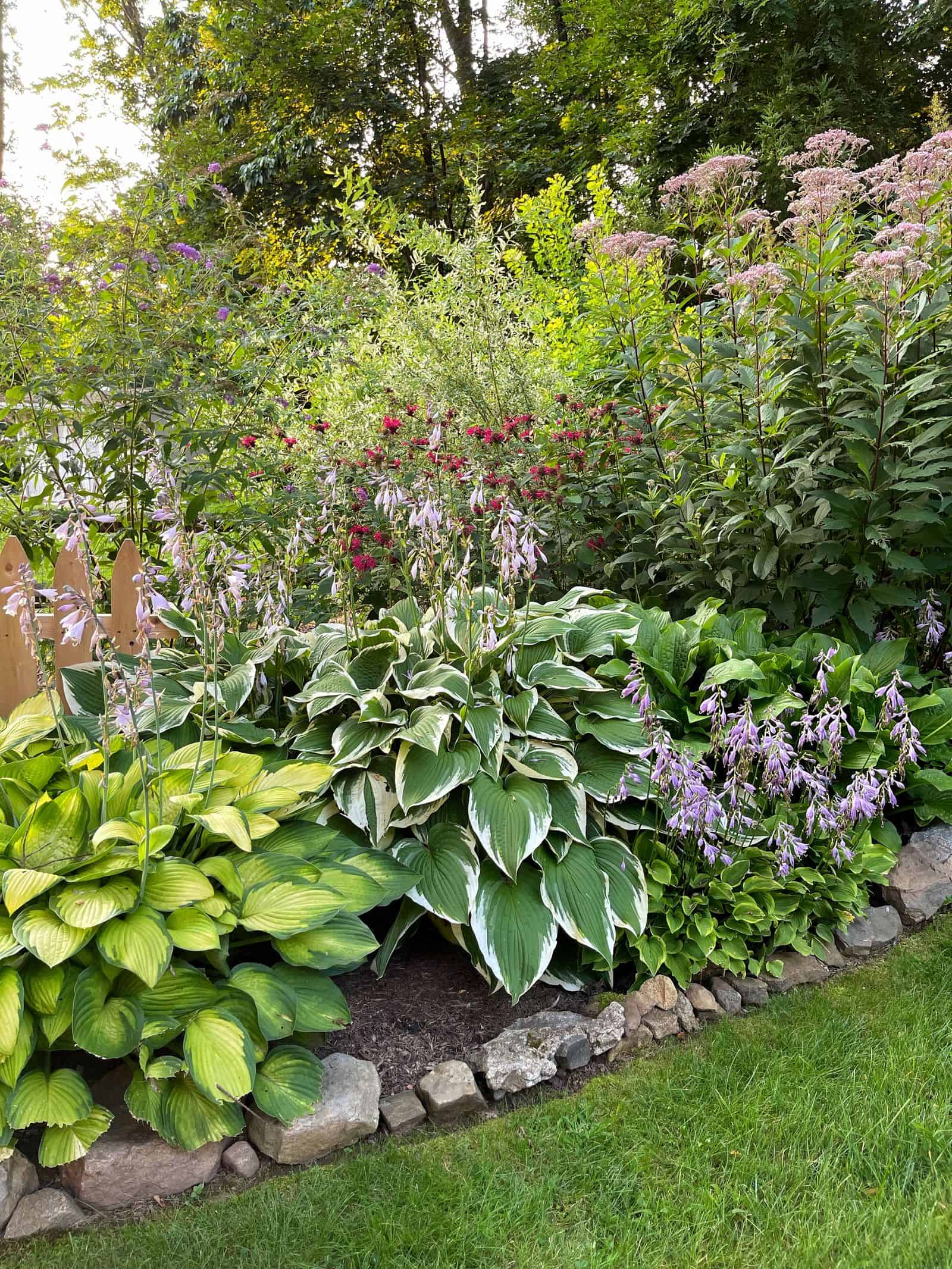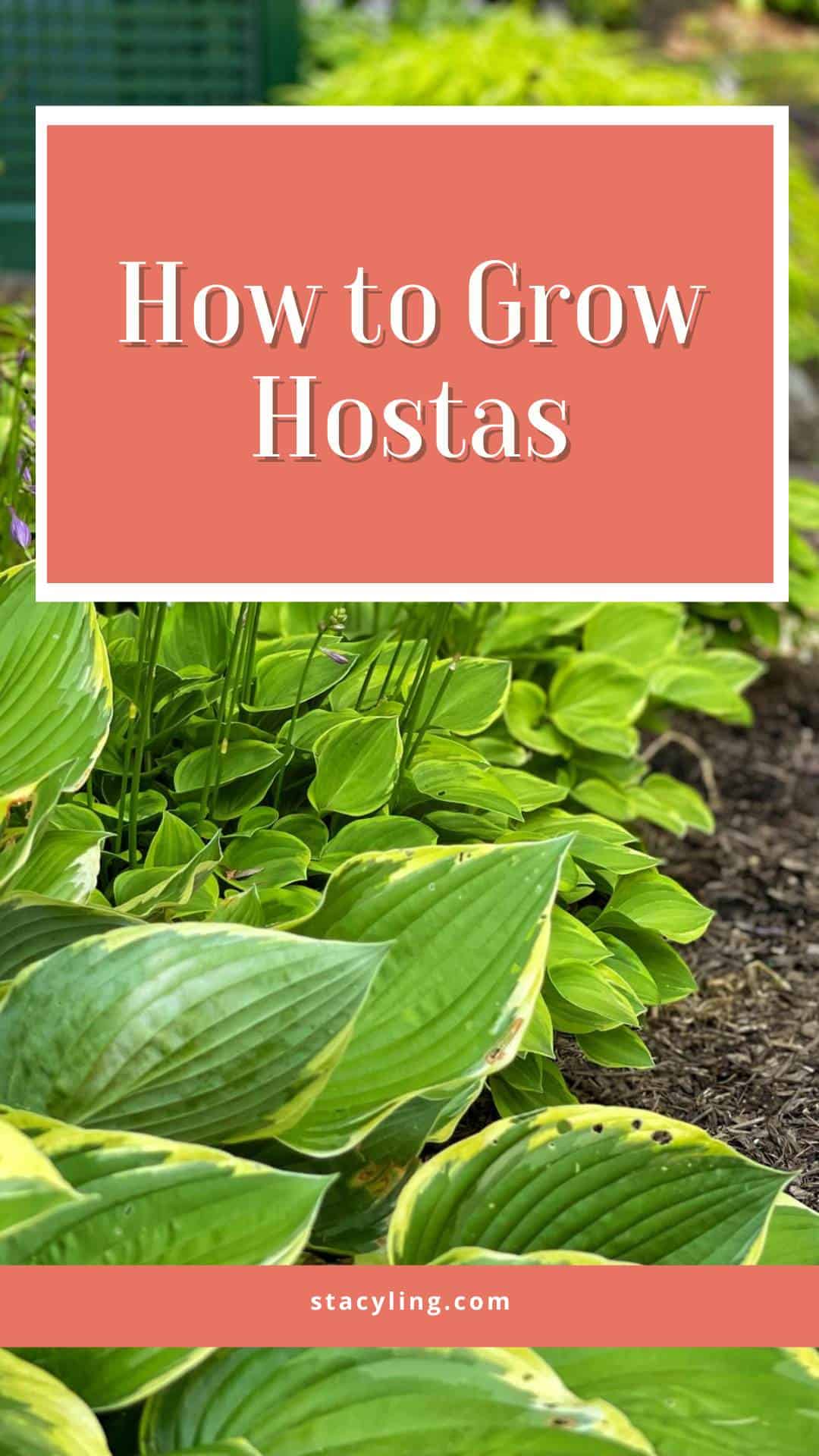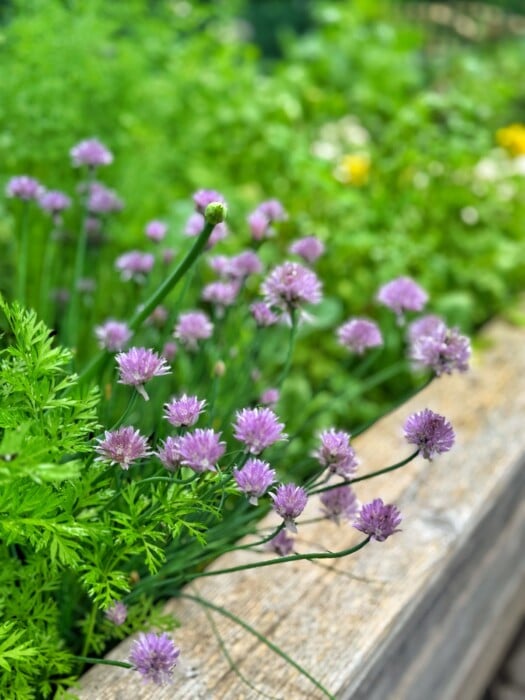Hosta plant care made easy! Your guide to healthy plants: planting, watering, pest control, and expert tips for beautiful foliage.
Welcome to your complete guide to hosta plant care for thriving shade gardens! Hostas are beloved for their lush foliage, effortless growth, and ability to brighten shady spots. This guide will walk you through everything you need to know, from selecting the perfect location and preparing the soil to preventing pests and dividing your plants.
Discover expert tips for growing healthy, vibrant hostas that add texture and color to your garden all season long. Whether you’re a seasoned gardener or just starting out, you’ll learn how to maximize the beauty of these shade-loving perennials. Let’s dive in and create a stunning, hassle-free hosta garden!
(Posts on stacyling.com may contain affiliate links. Click HERE for full disclosure.)


Understanding the Hosta Plant
Hostas (plantain lily) are a popular perennial plant, known for their striking foliage and ability to thrive in shady areas. Hardy in zones 3-9, they range in size from small to giant hostas. Plantain lilies bloom in summer and are an asset to any perennial garden.
- Common Name: Hosta
- Plant Type: Perennial
- Hardiness Zone: 3-9
- Light: Partial to full shade
- Soil Requirements: Well-drained, rich, moist
- Height: 1-3 feet
- Width: 1-4 feet
- Flower Color: White, lavender, purple
- Foliage Color: Green, blue, variegated
- Bloom Time: Summer

The Benefits of Growing Hosta Plants
Hostas are a must-have for shade gardens, offering numerous benefits:
- Stunning Foliage: A diverse range of colors, textures, and patterns adds visual interest and a luxurious feel.
- Beautiful Blooms: Tubular flowers in summer attract pollinators like bees and hummingbirds.
- Easy Care: Low-maintenance and hardy, hostas thrive with minimal effort, making them perfect for any gardener.
- Long Season: Enjoy vibrant foliage from spring through fall, with added summer blooms for extra color.
- Wildlife and Pollinator-Friendly: The beautiful foliage can provide valuable habitat for wildlife in your garden, hosta plants also attract beneficial insects such as bees, hummingbirds, and butterflies with those pretty tubular blooms.

Where Do Hosta Plants Grow Best?
Low-maintenance hostas are shade-loving plants that are native to wooded areas in East Asia where their natural habitat consists of moist, fertile soils with filtered or dappled sunlight. Plantain lilies are easy to grow and require very little from gardeners to thrive. Here’s what you need to know.
- Plant in shade or partial shade as direct sunlight can scorch their leaves. Filtered or dappled sunlight, such as under trees or near tall shrubs, is ideal for most hosta varieties.
- Plant in moist, well-draining soils that are rich in organic matter. The hosta plant prefers slightly acidic to neutral soil pH (around 6.5 to 7.5).
- They make great underplantings for tree canopies and woodland gardens.
- Give them room to grow as hosta plants grow into large clumps over time. Avoid overcrowding hostas and provide sufficient spacing according to the specific variety’s mature size so they get good air circulation between plants.

Planting Hostas in
Hostas are shade garden plants that thrive in well-draining, rich soil. Here’s a step-by-step guide to ensure successful planting:
- Choose the Right Location: Select a shaded area with dappled sunlight, avoiding direct afternoon sun which can scorch the leaves.
- Prepare the Soil: Enrich the soil with organic matter like compost to improve drainage and fertility.
- Spacing: Space plants 1-3 feet apart, depending on the variety, to allow for their mature size.
- Planting Depth: Dig a hole twice the width of the root ball and as deep as the root ball. Place the hosta in the hole so that the crown is level with the soil surface.
- Watering: Water thoroughly after planting and keep the soil consistently moist but not waterlogged while they establish.

When to Plant Hostas
The best time to plant hostas depends on your specific climate and growing conditions. In general, hostas are typically planted in the spring or fall when the weather is cooler and the soil is moist and workable.
Plant hostas in the spring, when the soil has thawed and the ground can be worked. It’s easiest to plant in early spring when the plant is still dormant because they are easier to establish.
You can also plant hostas in fall up until the ground freezes. However, it’s best to get them in the ground weeks before so they have time to establish before the ground freezes. Because I wait for nursery stock to go on sale in the fall, I have waited until late October and even early November to plant hostas and other perennials.
It’s important to note that hostas are not typically planted during the hottest part of the summer, as the stress of high temperatures and intense sunlight can be detrimental to their establishment. While planting hostas can be done during the summer, it’s easier to plant them in spring or fall.

Hosta Plant Care Tips
Keep in mind that most hostas prefer well-drained soil that is rich in organic matter in shadier locations. While hosta plants can tolerate some morning sun, too much direct sun can scorch their leaves.
Watering Tips for Thriving Hostas
In terms of caring for hostas, they require regular watering, especially during dry periods. However, once they are well established can handle drier conditions. Water newly planted hostas regularly until they become established. But keep an eye on them because it’s important not to overwater them. How much you water will depend on the weather in your climate.
Since I typically plant mine in spring or fall, I let nature do its thing because we get enough rain here and the temperatures are cooler. When they are established, reduce watering thoroughly to roughly once or twice a week depending on the weather in your climate.
Hostas are fairly drought-tolerant once established but may require more watering during periods of extreme heat or dryness.

Fertilizing Hostas
Plaintain lilies do not require fertilizing to thrive. Instead, focus on providing them with good-quality soil conditions. You can amend the soil yearly with good-quality compost, leaf mold, and mulch. The only time I fertilize perennials is when they are grown in pots.
Dividing Hostas: Step-By-Step Directions
The best method to propagate is to split hostas. It’s very easy to do, helps improve overall plant health, and can grow your garden in well under an hour. Follow these steps to divide hostas:
- Choose a cool, overcast day to divide hostas. This will help prevent the roots from drying out. The easiest way to do this is after lots of rain because the ground will be easier to dig and the plant will have been watered well making the process a little easier for you.
- Dig up the entire root clump with a spade shovel, being careful not to damage the roots. It’s easier to go around the perimeter of the plant first, and then slice through to create sections so you can remove a hosta clump with ease. Oftentimes I like to use a garden fork after the spade to help gently lift the large clump out of the ground.
- Gently shake off the excess soil from the roots, and then use a clean garden knife or sharp spade to divide the plant into smaller clumps. I don’t use a sharp knife for this, but I know some gardeners that do.
- Each clump should have several healthy new shoots and a good root system.
- Replant the smaller sections in their new home at the same depth they were originally growing, and water them thoroughly.
- Mulch around the base of the plants to help retain moisture.
- And give them lots of water after transplanting. They need it!
The best time of year to divide hostas is in the early spring, just as new growth begins to emerge. This will give the plants time to establish themselves before the heat of summer arrives.
But hostas can also be divided just as easily in the fall. As long as the ground can be worked, you can divide them. Just be sure to do it before the ground freezes so the plant has time to establish itself before winter.
As an aside, an ideal time to divide hostas is after and before a good rain is expected. The plants are easier to divide and lift out of the ground. Plus, the new divisions will take and establish easier with little to no work from you.
Divide hostas regularly, so you can keep the plants healthy and vigorous, and create new plants to share with friends and family. For more information about how to split hostas, I shared greater details in this article here.

Cutting Back Hostas
Hostas can be cut back in the fall after the first frost or in the spring before new growth appears. To cut back hostas, remove any yellowing or dead foliage and cut the remaining leaves down to a few inches above the ground.
As an aside, it’s better to keep the gardens intact until spring. Pollinators may have laid eggs on the foliage, which offers protection for some wildlife, provides winter interest, and when left in the garden the garden helps feed the good microbes in the soil.
What happens if you don’t cut hostas back?
If you don’t cut back hostas plants, they will continue to grow and mature naturally. They are tough and resilient plants that won’t get offended if don’t cut them back. I love the look of them as they die back in fall because they add pretty autumnal color to the gardens as they go into dormancy.

Growing Hostas in Pots
I love the look of hostas in pots. They look really pretty and graceful as the foliage spills over the edges of the pot. A word of advice though about growing them in containers. If you want to grow them for more than a year or two, you’ll need to either plant them in the ground or repot them with fresh potting soil. If you choose the latter, gently remove as much soil off the roots as you can and then repot in fresh potting soil. You can either repot in the same container or go one size up.
To successfully overwinter hostas in containers where winters are cold, choose varieties that are two times your hardiness zone. So if you garden in zone 6, they need to be able to handle zone 4.
- Choose a container with a diameter and depth of at least 12 inches depending on the size of yoru hosta plant. Make sure the container has drainage holes to allow excess water to escape and prevent waterlogging.
- Use a well-draining potting mix. Plant one hosta plant per container and maintain them in part sun to full shade. Rotate the container periodically to ensure even sunlight exposure on all sides of the plant if necessary.
- Containers dry out faster than the ground, so it’s important to water them regularly, checking the soil moisture level with your finger or a moisture meter. Avoid overwatering, as soggy soil can lead to root rot. Allow the top inch of soil to dry out slightly between watering. To make things simpler, I like to set my containers on a drip irrigation system with a timer so it’s set and forget.
- Fertilize hostas in pots in spring with a balanced slow-release fertilizer formulated for flowering plants and follow the package instructions for application rates and frequency.
Want to learn how to grow hostas in pots? I’ve got you covered! Check out my full guide here.

Common Pest and Disease Problems With Hostas
Hostas are generally resilient, but they can still face several pest and disease challenges. Here are some common issues and how to address them:
- Slugs and Snails: These pests can cause significant damage by chewing holes in the leaves. Use iron phosphate-based slug pellets like these, set up beer traps, or create barriers with copper tape to deter them.
- Deer and Rabbits: These animals find hostas appetizing. Use deer repellents, fencing, or plant varieties that are less attractive to them. This deer repellent works well on both!
- Foliar Nematodes: These microscopic worms can cause yellow streaks on the leaves. Infected plants should be removed and destroyed to prevent the spread.
- Crown Rot: Often caused by poor drainage, this fungal disease leads to rotting at the plant’s base. Ensure proper soil drainage and avoid overwatering.
- Virus X: This virus causes mottled, twisted leaves. There is no cure, so infected plants must be removed and destroyed.

Hosta Plants Are Not Deer Resistant Plants
While some hosta varieties are more deer-resistant than others, they are generally a smorgasbord for deer. Deer damage is a drawback to growing hostas plants if you live in areas that have a heavy deer population. But the good news is, you can still grow hostas. However, these full-shade flowers and foliage will need protection.
Protecting Hostas from Deer Damage
To protect hostas from deer damage, there are several methods you can try. One option is to install a physical barrier around the plant, such as a fence or netting. Another option is to use deer-resistant plants to create a border around the hostas.
But you can also try using natural deer repellents. Lately, I have been using Plantskyyd deer repellent and LOVE IT because it is not only topical but also gets taken in by the plant. For several years, I have also used Deer Out and that works really well too. But you can also try using this granular called Deer Scram as a barrier to plants and full borders. I discussed how to use both of these simultaneously for extra protection from deer in this post.
The key to using repellents is to start spraying them as soon as they emerge from the ground. Deer need to know early on the plant is not palatable so they choose a different path.
I spray my hostas the moment they emerge from the ground, and then a few more times as they grow until they reach their mature size. After that, it’s more maintenance spraying depending on the product. Since Plantskyyd is systemic, that spray schedule will be less than Deer Out. Try to find the best repellent situation that works for you and your schedule. But both of these options have worked very well for me.

Protecting Hostas From Slugs
Slugs can be a problem for hostas but they are easy to remedy. I use an organic slug bait like this to keep them at bay. Fortunately, there are several ways to protect your hostas from these critters putting holes in that gorgeous foliage.
- Handpicking is a simple but effective method of removing slugs from your hostas. Go out at night with a flashlight and pick off any slugs you find. You can dispose of them in a bucket of soapy water.
- Copper is toxic to slugs, so you can create a barrier around your hostas using copper tape or wire. This will prevent the slugs from crawling over and reaching your plants.
- Mulching around your hostas with materials like crushed eggshells, diatomaceous earth, or coffee grounds can help deter slugs. These materials are abrasive to slugs and can also absorb moisture, making the environment less hospitable for them.
- Encouraging natural predators like birds, toads, and hedgehogs to frequent your garden can help control slug populations. You can provide a habitat for these creatures by creating a small pond or installing birdhouses and feeding stations.
- Try using slug bait. There are lots of organic ones available.
Remember to regularly inspect your hostas and take action as soon as you spot any signs of slug damage to prevent it from becoming a bigger problem.

Top Types of Hostas
There are thousands of varieties of hostas, each with unique leaf shapes, colors, and sizes. When selecting hosta varieties, consider factors such as the mature size, foliage color, texture, and flower characteristics to suit your gardening needs and aesthetic preferences.
Here are some of my favorite popular hosta varieties:
- ‘Sum and Substance’
- ‘Frances Williams’
- ‘June’
- ‘Patriot’
- ‘Guacamole’
- ‘Halcyon’
- ‘Stained Glass’
- ‘First Frost’
- ‘Empress Wu’
- ‘Hadspen Blue’
- Proven Winners ‘Shadowland Diamond Lake’
- Proven Winners ‘Shadowland Echo the Sun’
- Proven Winners ‘Shadowland Voices in the Wind’
- Proven Winners ‘Shadowland Wheee!’

Hosta Plant FAQs
Do Hostas Grow Back Every Year?
Yes, hostas are perennial plants, which means they come back year after year when provided with suitable growing conditions. Hostas plants are known for their lush foliage and are commonly grown for their attractive leaves. While the leaves may die back during the winter months, hostas typically go dormant and then re-emerge in the spring, producing new leaves from their underground rhizomes.
These full-shade flowers are hardy perennials that can survive winter temperatures in many regions, depending on the specific variety and climate.
Hostas are known for their long lifespan, and with proper care and maintenance, they can persist and thrive in the same location for many years. I planted hostas when we first moved to our family home over 23 years ago and they still thrive today!

Can Hostas Take Full Sun?
In general, plantain lilies are shade-loving plants by nature and are typically best suited for partial to full shade conditions. However, some hosta varieties can tolerate a little more sun depending on the specific climate, location, and variety. So you’ll need to do some research before planting.
Some believe that hostas with lighter-colored or variegated leaves, as well as those with thicker foliage, tend to be more sun-tolerant compared to those with darker green leaves and thinner foliage. Additionally, hostas that are grown in cooler climates or regions with mild summers may be able tolerate more sun than those in hot and sunny regions.
I don’t recommend planting them in full sun, particularly where the afternoon sun in the summer can scorch the foliage. But it’s your garden, so feel free to experiment to learn your microclimate. If they don’t do well, you can always dig them up and relocate them.
If you choose to plant in full sun or partial sun, aim for the morning sun as it’s generally milder and provides them with adequate moisture. But mulch well around hostas to help retain moisture and regulate soil temperature.
After planting in sun, keep an eye on your hostas for signs of stress. If you notice wilting or leaf burn, it would be a good idea to relocate them to a shadier location if you want them to thrive.

Final Thoughts About Hosta Plant Care
After 25 years of growing hostas, I can confidently say they’re one of my absolute favorite shade garden plants. Honestly, since moving to this property with its abundance of shade, I’ve become a full-fledged hosta addict! From the vibrant greens to the stunning variegated varieties, they bring such a sense of lushness and easy-care beauty to my gardens.
If you’re looking to create a low-maintenance, visually captivating shade garden, hostas are your answer. By following the tips in this guide, you’ll be well on your way to enjoying thriving hosta plants for years to come. Trust me, whether you’re a seasoned pro or just starting out, the reward of watching these gorgeous plants flourish is truly unmatched.

For more information about growing hostas, see these university extension articles:
Do you have a favorite hosta variety you love to grow? I would love to know more in the comments below.
If you have any questions, comments or suggestions, please let me know in the comments below. I’d love to hear! And feel free to share this post with anyone you think would find it helpful too.
To drill down on more beginner gardening techniques and tips, please read these posts:
- Flower Gardening 101
- Growing a Cut Flower Garden for Beginners
- Container Garden Ideas for Beginners
- How to Start a Vegetable Garden
- Herb Gardening for Beginners
Thank you for visiting the blog today!
Enjoy your day! xo








